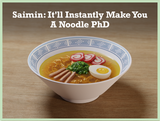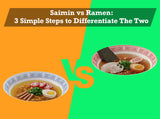
The three main elements that make up a bowl of ramen are the broth, the toppings and the noodles.
We've talked a great deal about the broth and ramen toppings in previous blog posts.
What about the noodles?
Here’s a question for you to think about...
What is the function of kansui (alkaline solution) in the production of ramen noodles? Choose the statement that is incorrect.
With the addition of kansui...
A. The noodles become yellow in colour.
B. The noodles become chewy.
C. The noodles become wavy.
D. The noodles get some ramen noodle flavor.
The answer is...
"C"
What are ramen noodles? Many people think it is complicated since many different elements, such as the broth and sauce, need to come together to make up the perfect bowl of ramen.
However, it is actually quite simple.
Ramen noodles are a mixture of wheat flour, water, and kansui.
Kansui is an alkaline solution (usually sodium carbonate or potassium carbonate). Sometimes baking soda is used instead of kansui.
Kansui makes noodles...
1. Yellow,
2. Chewy, and
3. Gives it its distinct ramen noodle flavor.
So how did people know to add kansui to wheat flour and water to make ramen?
Long ago in Inner Mongolia, some people made noodles out of flour and water from a salty lake. The salt water had sodium chloride, and the completed noodles were chewy and had a nice flavour. 
Since then, this type of chewy noodles have gotten very popular and spread all over China.
The lake is called Kanko (鹹湖) and the water is called kansui (鹹水).
Sometimes, egg yolks or egg whites are mixed with the noodles. Eggs improve the noodles' color and chewy texture.
There are many variations of ramen noodles, for example, the thickness of the noodles is decided by the size of the noodle cutters. 
The standard of this size is determined by how many pieces of noodles you can cut out from a piece of 30mm (1.181 in) dough.
For example, cutter number 7 makes 30(mm)/7 = 4.29mm noodles (0.168 in) which is udon thickness.
For ramen, usually cutter number 12 to 28 are used.
The smaller the cutter number, the thicker the noodles.
Cutter number 12 makes 2.5mm (0.098 in) noodles which is considered very thick for ramen noodles. They are used for Kitakata ramen (from Fukushima).
On the other hand, cutter number 28 makes 1.1mm (0.043 in) noodles which is considered very thin. They are used for Hakata ramen (from Fukuoka).
Very thick
Cutter number 12: 2.5mm (0.098 in) Kitakata Ramen (Fukushima)
Cutter number 14: 2.2mm (0.087 in) Sano Ramen (Tochigi), Kitakata Ramen (Fukushima)
Thick
Cutter number 16: 1.875mm (0.074 in) Shirakawa Ramen (Fukushima)
Cutter number 18: 1.7mm (0.066 in) Shirakawa Ramen (Fukushima), soba
Standard
Cutter number 20: 1.5mm (0.059 in) soba
Thin
Cutter number 22: 1.4mm (0.055 in) Sapporo Ramen (Hokkaido), soba
Cutter number 24: 1.25mm (0.049 in) Tokyo Ramen, Asahikawa (Hokkaido) Ramen
Cutter number 26: 1.15mm (0.045 in) Hakata Ramen (Fukuoka), Kumamoto Ramen, somen
Very thin
Cutter number 28: 1.1mm (0.043 in) Hakata Ramen (Fukuoka), somen
Do you know the difference between thin and thick ramen noodles?
Actually it is not that simple.
I will be talking about the thickness of ramen noodles.

Characteristics of thin noodles are...
They have a higher surface area to volume ratio in contrast to thick noodles, so the soup can seep through and cover thin noodles better.
The combination of thin noodles with flavourful soup is wonderful! The soup can cover thin noodles better than it does for thick noodles, you will also feel a smooth texture in your mouth, tongue, and throat.
However, thin noodles become soggy a lot easier than thicker noodles.
Characteristics of thick noodles are...
You feel like you ate a lot since thick noodles are voluminous, chewier and denser.
Thick noodles go well with thick, creamy and salty soup.
For thick noodles, in order to create an optimal surface area to volume ratio, chefs make the noodles wavy so the soup can coat all the noodles evenly.
Thick noodles are used in Yokohama iekei ramen and Kitakata ramen.
Thick-noodled ramen make it easier to splash broth onto your clothes if you don’t eat carefully.
People might think the difference of thick noodles and thin noodles are only the size, but if you want to make thick noodles, you have to change the portion of flour.
You also need to increase water addition rate when you make thick noodles.
It make huge difference if you switch thin noodles to thick noodles, or thick noodles to thin noodles even though you use the same soup!
Did you know the shape of noodles make a difference taste-wise as well?
There are straight noodles and wavy noodles. There are square cross-sections and rectangular cross-sections too.

The shape of ramen noodles depends on how the chef or machine cuts it. This changes many factors of the ramen like its texture, taste, appearance and how much water they will absorb when put into soup.
For ramen noodles, a lot of restaurants use square or rectangular cross section-shaped noodles. However, spaghetti and somen's cross-sections are circular.
Basically, a lot of ramen restaurants use rectangular ones, but each restaurants have unique noodles that have different cross sections because the proportions are different.
Shape Style
Rectangular: Goes well with simple soup taste, like shio or shoyu ramen
Rectangular (vertical): Noodles in this formation absorbs the most soup
Rectangular (horizontal): Used for flat noodles as they have a smooth surface
Circular: They have a smooth texture. Used for noodles like somen or spaghetti
Have you ever thought about how much water should be added with the flour when you’re making ramen?
Let me explain...

Characteristics of noodles with very little addition of water:
The best way to enjoy this type of noodles is through Hakata ramen's kaedama (refill) system. New noodles are added into your broth each time you’re done eating. instead of sitting in your broth and becoming soggy.
Characteristics of noodles with lots of water added to it:
In contrast to the South, Northern Japanese ramen use noodles with high water content.
Sano ramen (Tochigi prefecture) and Kitakata ramen (Fukushima) use this high water addition rate ramen noodles.
Not only does the shape of the noodles make a difference in a bowl of ramen. Interestingly, the amount of one serving does too.
Do you know which type of ramen has the smallest single serving portion of noodles when it is served?
A. Sapporo Miso Ramen (Hokkaido) 
B. Hakata Tonkotsu Ramen (Fukuoka)

C. Tokyo Shoyu Ramen

The Answer is...
“B”
Of course it depends on the restaurant, but there are some distinctive differences of regional ramen. Do you know why Hakata tonkotsu ramen has the smallest portion?
It is because there is a system called "kaedama". It means an extra serving of noodles.
Kaedama system was originally used at ramen restaurants in Nagahama, which is in Fukuoka, Kyushu (southern part of Japan). Nagahama ramen was served for workers of a big fish market in that area.
Fish market workers were very busy in the morning and ramen stores did not want them to have to wait a long time for their ramen.
That is why Nagahama ramen was preferred because it can be cooked and served very quickly since they use very thin noodles.
For thin noodles, it takes about 2 to 3 minutes to boil, while thick noodles take about 6 to 7 minutes.
It takes thick noodles about 2-3 times longer to boil than thin noodles!
However, thin noodles gets soggy very quickly as they absorb the soup quickly.
Ramen chefs wanted the fish market workers to eat the noodles in its best condition, hence the kaedama refill system was put in place.
Nagahama ramen and Hakata ramen were originally different types of ramen even though these two places are geographically close to each other. However, Nagahama ramen influenced Hakata ramen that is why kaedama system is used for Hakata ramen as well.
Going back to the question in the beginning, the portion of noodles goes something like this...
Sapporo miso ramen, Tokyo shoyu ramen: 5.3oz (150g) - before boiling
Hakata tonkotsu ramen: 3.5oz (100g) - before boiling
So, are you interested in making your own noodles at home by now?
Sounds difficult and impossible?
No, it is actually very SIMPLE!
Here's my go-to (egg-free) recipe:
Ingredients (for 6 bowls):
Wheat Flour 500g
Baking Soda 5g
Water 220cc
Salt 5g
Potato Starch* - As you see fit
Tools:
Rolling Pin
Knife
Cutting Board
Measuring Cup
Measuring Spoon
Directions:
1. Mix baking soda, salt, and water together
2. Mix flour with 80% of the liquid mixture you made in the previous step. Leave some of it for use later.
3. Wrap dough with a plastic wrap for 5 minutes
4. If the dough looks a little too dry, add the liquid from "step 1" little by little until it is the right consistency
5. Put the dough into a large plastic bag and step on it to make it flat.
6. Fold the dough and put it back in the plastic bag and continue stepping on it until it gets flat again. Repeat this step 3 times.
7. Roll the dough into a ball-shape and cover it up with a plastic wrap
8. Let it sit for one hour
9. Divide the dough ball into 6 equal portions. Using a rolling pin, flatten out each of the portions separately.
It may be a little hard at the beginning to roll it out. But as the dough becomes flatter, it becomes easier to roll it out.
10. Fold the sheet of dough into itself until it is 10cm in width. Be careful when folding, do not press too hard or the dough may stick together.
11. Cut the folded sheet of dough using a knife
TIP: Try to push your knife from the top against the sheet. Do not slide your knife.
12. Once cut, loosen the noodles a bit. If you want to make the noodles wavy, knead the noodles lightly.
The potato starch in the recipe is to be powdered onto a wooden board before you start rolling out the dough. This powdery substance prevents noodles from sticking together.
Now that we've shared some ramen broth and ramen noodle recipes with you, you should be confident in recreating a Japanese meal in the comfort of your own home!
You'll need the right bowls and utensils to help with that! Why don't you take a look at some of our favorites? We think you'll love them too!
Want to review our recipes again? Check them out here!
11 Crucial Differences Everyone Should Know: Ramen vs. Pasta




Hello Opal,
Thank you for leaving us a comment on our blogpost!
It might be a little difficult to find gluten-free ramen.
But luckily, we do have a recipe you can use that teaches you how to turn spaghetti into ramen:
https://apexsk.com/blogs/japan-lifestyle/substitutes-for-hard-to-find-japanese-ingredients-like-mirin-dashi-and-even-ramen?pos=1&_sid=b4f5c7e98&ss=r
Gluten-free spaghetti is probably much easier to find than gluten-free ramen.
The recipe does require baking soda.
So when selecting a baking soda, be sure to select a gluten-free option that is not made from a wheat starch.
Hope that helps!
I must eat gluten free. Are there any gluten-free Ramen noodles that can be purchased?
Leave a comment